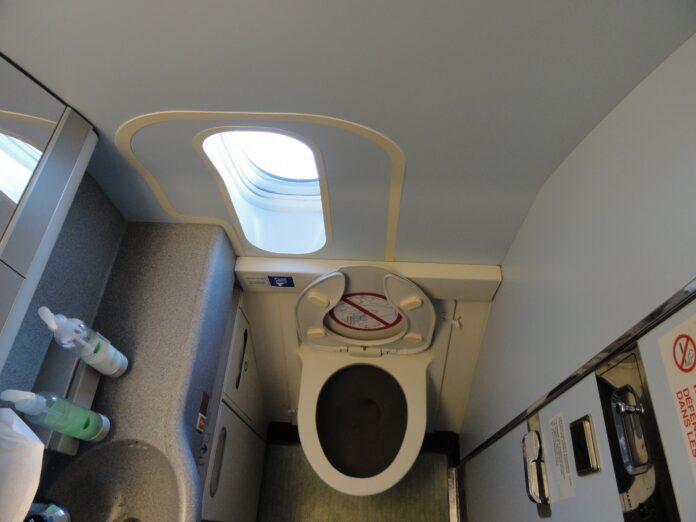October half term is a prime-time for families to jump aboard a plane and jet off to a fun family destination, making it one of the busiest periods of the year for travel.
However, with the busy travel period in mind, should Brits have a heightened awareness when it comes to the cleanliness of aeroplane loos?
A former flight attendant, with over five years’ experience working for a major airline, lifts the lid on why this part of the plane is widely considered, within the airline industry, to be the dirtiest place on the aircraft.
Speaking to bathroom specialists, Sanctuary Bathrooms, the flight attendant (who has contributed anonymously) reveals some of the dirtiest aircraft bathroom secrets. Including how often the loos gets cleaned, the worst times to use them during a flight, and the important do’s and don’ts for when it comes to getting some much-needed mid-flight relief.
How often are the loos cleaned?
“An important part of the airline industry is turnover,” says the former cabin crew member. “This sometimes means that a full, deep clean of the aeroplane loo isn’t always possible due to lack of time and higher priorities. Generally, the cubicles get a quick wipe down straight before a flight. Then during the flight, they tend to be checked every half an hour or so but again, if there are more urgent things going on, checking on the cleanliness of the loos can fall down the priority list.
“Some passengers might not be aware that the sewage tank (that collects all the waste from the loos) is onboard and there can sometimes be several, depending on the size of the plane. This tank is supposed to get emptied once the plane has landed but with 2022 being one of the busiest years for flights, it can often be a couple days before it gets fully emptied. If the sewage tank was to overflow, there is a risk that pipes could burst and their contents could get into the aircraft – which has happened before!”
When is the worst time to use the loo during a flight?
According to the former air steward, “the worst time to use the aeroplane loo is right before take-off (some people do!) and at the very end of a flight, especially if it’s long-haul. It can be equally bad after a bumpy spot of turbulence during which time the seat belt signs would have been turned on. As soon as they are turned off, you’ll get an influx of people needing the loo, as well as people who potentially feel the need to be sick.
“Equally, try to go before food is served. Plane food is not nutritious. It can be oily and high in salt and fat; things that don’t tend to be great for gut health or bowel movements. If a meal isn’t sitting right with one passenger and they need to use the loo because of it, you don’t want to be in there straight after.”
The do’s and don’ts, according to a former flight attendant:
1. Do: wear a mask in the loo
“The aeroplane loo is essentially a cupboard, with no clean air. There is no window and the air ventilation is poor. This means that every time you go to the loo, not only are you breathing in the air of many others who have ‘done their business’ before you (especially if it’s a long-haul flight) but you could also be breathing in potential faeces particles, circulating the air after a toilet flush.”
2. Don’t: clean your teeth
“Do not clean your teeth in an aeroplane loo. The water on a plane all comes from the same water tank and it is not filtered. If you really need to, used bottled water but my main piece of advice would be, do not take your toothbrush or wash bag anywhere near an aeroplane loo.”
3. Don’t: touch any surfaces – including the loo seat
“It sounds dramatic but I highly recommend you avoid direct contact with as many surfaces as possible, in the aeroplane loo cubicle. That starts from opening the door. Use your foot or wear plastic, disposable gloves to touch the handle.
“Most aeroplane loos have wipes next to the sink, which are there to be used – wipe down every surface before you touch it. If that’s not possible, take some sheets of loo roll and use them to avoid touching anything directly with your fingertips. Worst case scenario, use your knuckles, rather than your fingers and hand sanitise straight after.
“Finally, try your best to hover over the loo seat and avoid actually sitting down and touching it. If you’re finding it hard to balance, there are usually handles that you can hold on to, but again, wipe them down first or cover them with loo roll. The same applies to touching the flush button.”
4. Do: shower straight after your flight
“Because of the poor air circulation on a plane (especially in the loos) as well as the number of surfaces that can harbour a lot of germs, you could leave your flight with dirty hands, hair and clothes. As soon as you arrive at your destination, put your clothes in the wash and have a good scrub. I always used to shower straight after work and sometimes the water would turn brown!”
5. Don’t: take your shoes off – ever!
“Sometimes people remove their shoes to walk around the plane but do not step sock-footed and even barefoot, into an aeroplane bathroom! Due to the high chance of unbalance and people missing the toilet bowl, there could be urine on the floor. Imagine if you carried this from your sock, into your shoe and back into your home – that would be incredibly unhygienic!”
6. Carry hand sanitiser
“Post-covid, regular handwashing is now a lot more frequent and the use of hand sanitiser, whilst on the go, is now part and parcel of our daily routine. These personal hygiene practices should definitely be implemented when travelling, especially for moments like using the aeroplane loos. Most flight attendants have always carried pocket-sized bottles of hand sanitiser around with them on flights, to use when necessary and I would encourage passengers to do the same. Especially before and after visiting the loo (as well as washing your hands with soap).”
James Roberts, Director of Sanctuary Bathrooms, who spoke to the former cabin crew member, comments on the do’s and don’ts: “Some of this shocking insight – both garish and grim in some respects – really illustrates how germs and grime can build up quickly in high traffic areas, and particularly in poorly ventilated spaces. Combine this with the fast turnaround times and cleaning time that all aircrafts have to accommodate due to operational issues and aircraft slot times, and you have the perfect combination for germs building up and spreading.
“Despite this, the obvious fact – particularly on long-haul flights – is that when you have to go, you have to go and so it isn’t always possible to avoid onboard aircraft toilets! This insight, and the useful tips provided, can encourage travellers to be more hygienic on their flight. This not only can help reduce or slow down the risk of germs and spread of them, but also provide a better experience for other passengers too. This also provides best practice and good hygiene for any bathroom whether at home, in a bar, or at 30,000 feet: sanitise, ventilate where possible and make sure surfaces are clean before and after use. Finally, if you’re returning from holiday, make sure you’re first in line for the shower!”
Help keep news FREE for our readers
Supporting your local community newspaper/online news outlet is crucial now more than ever. If you believe in independent journalism, then consider making a valuable contribution by making a one-time or monthly donation. We operate in rural areas where providing unbiased news can be challenging. Read More About Supporting The West Wales Chronicle


























